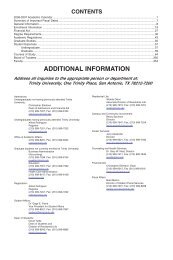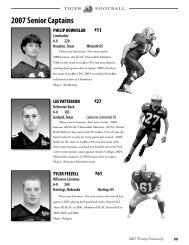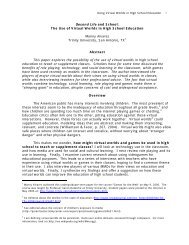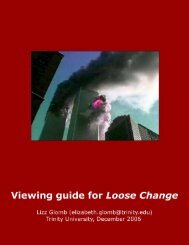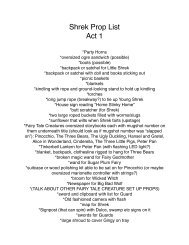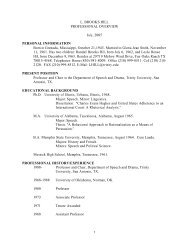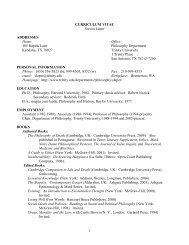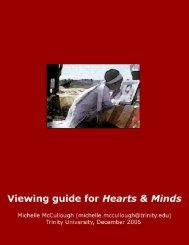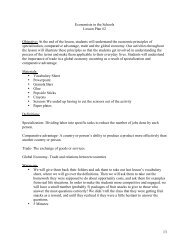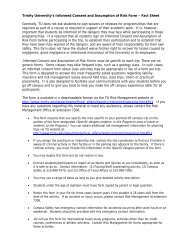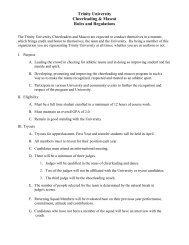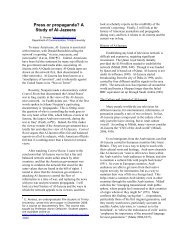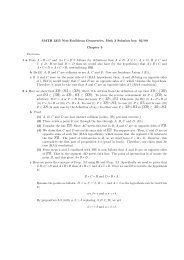Reviews - Trinity University
Reviews - Trinity University
Reviews - Trinity University
You also want an ePaper? Increase the reach of your titles
YUMPU automatically turns print PDFs into web optimized ePapers that Google loves.
<strong>Reviews</strong>
BORDER MATTERS: REMAPPING AMERICAN CULTURAL STUDIES. By Jose<br />
David Saldivar. (Berkeley: <strong>University</strong> of California Press, 1997.<br />
xvi, 251 pp. cloth $40.00, paper $15.95.)<br />
Judging by the recent spate of titles invoking the metaphor of<br />
the U.S.-Mexico border, including a recent volume of this journal<br />
(“Borders,” Aztlun 21, nos. 1 and 2), we are now fully<br />
immersed in an era of “border theory.” The roughly 2,000-mile<br />
international boundary from San Diego/Tijuana to Brownsville/Matamoros<br />
is no mere geopolitical fiction; it also works<br />
as a counterhegemonic discursive object targeting ossified critical<br />
frameworks in the human sciences. It has had its most<br />
telling impact as a metaphor with which scholars symbolically<br />
imagine both their disciplines and postmodern, post-national<br />
subject formations. The contours of a borderlands school of<br />
cultural criticism remain to be seen in their full light, but Jose<br />
David Saldivar’s recent contribution to this area of scholarship<br />
will no doubt have a lasting impact on subsequent work<br />
on Chicano literature and culture, and, one hopes, on contemporary<br />
efforts to refine American Studies generally. Border<br />
theory owes a little to each of a number of recent critical<br />
methodologies-deconstruction, ecocriticism, feminism, the<br />
new historicism-and Saldivar remains cognizant of the danger<br />
that it might be dismissed, along with postmodernism, as<br />
a “trendy paradigm of crossing, circulation, and resistance,”<br />
a dismissal that would not “do justice to the complexities of<br />
the transfrontier issues of our time” (186). His careful and<br />
usually compelling readings of cultural artifacts arising out<br />
of the “open wound” (as Gloria Anzaldua poignantly describes<br />
the region) created in the aftermath of the Mexican-American<br />
War, or la Guerra de la Intervencion Nortearnericana as it is<br />
known in Mexico, could hardly be dismissed as trendy. Instead,<br />
Saldivar self-consciously works to reconstruct the “American<br />
western field-Imaginary of the American West” in terms of<br />
the things said and concealed about migration and<br />
immigration; the enunciations required and those<br />
Aztlcin 23:l Spring 1998 135
Sot0<br />
forbidden about the legacy of conquest in the Americas.<br />
In my view, border discourse not only produces<br />
power and reinforces it but also undermines it,<br />
makes it fragile, and allows one to map and perhaps<br />
thwart the cultures of U.S. empire. (xiii-xiv)<br />
If Saldivar’s formulation of his project sounds like an updated<br />
version of the new historicist model of subversion and<br />
containment, although a less cynical one, the resemblance is<br />
no accident. He readily acknowledges his debt to his new historicist<br />
colleagues Stephen Greenblatt and Jose E. Limon, as<br />
well as predecessors like Michel Foucault and Raymond Williams.<br />
In similar fashion, Saldivar levels the distinctions between<br />
high and low, between folklore and elitelore, allowing a<br />
wide range of discourses (corridos, critical theory, ethnography,<br />
hip hop, painting, poetry, prose fiction, Tex-Mex conjunto,<br />
travel writing) to enter his field of vision. Not surprisingly,<br />
Saldivar is most successful in his work on strictly literary artifacts:<br />
trained in comparative literature, Saldivar makes only<br />
limited use of art historical and musicological approaches,<br />
emphasizing instead the discursive aspect of popular music<br />
and the semiotic component of the plastic arts.<br />
Like its older and bigger sibling, American Studies, Chicano<br />
Studies necessarily plants itself in the rich soil of cultural<br />
analysis, that contact zone between anthropology and literary<br />
criticism, even when this relationship remains unarticulated.<br />
Both disciplines, as wide-ranging as they are, inevitably<br />
return to the question, “What constitutes X culture?” The<br />
sometimes unfortunate corollary to this question-“What constitutes<br />
X identity?”-tends to straitjacket itself in the tautological<br />
logic of essentialism, assuming, for example, that onZy<br />
the romance-novel comprises the American literary tradition,<br />
or that only folklore captures Chicano reality. More disturbingly,<br />
these discourses have at times suggested that only the<br />
frontier experience accounts for America’s social institutions,<br />
and that only the border experience explains the Chicano way<br />
of life. By aligning his project with the ongoing work carried<br />
out under the auspices of the Centre for Contemporary Cultural<br />
Studies in Birmingham, and the Center for Cultural Studies<br />
in Santa Cruz (which Saldivar helped mold into an<br />
important critical force), Saldivar invokes models for future<br />
research that are well-known for revealing the culturalconstructedness<br />
of ethnic and national identities, and more<br />
136
Border Matters<br />
important, for their sharp focus on the ideological and economic<br />
interests these identities serve.<br />
Border Matters begins by “shuffl[ing] the mainline U.S.<br />
Bildung of assimilation, acculturation, and the polyethnic<br />
state” (19); specifically, Saldivar unearths the migrant sensibilities<br />
and dislocated subject positions at work in four contemporary<br />
cultural theorists, Renato Rosaldo, Vicki Ruiz,<br />
George J. Sanchez, and Nestor Garcia Canclini. It is a bit farfetched<br />
to suggest, as does Saldivar, that Sanchez’s historiography<br />
(for example) “fundamentally debunks Oscar Handlin’s<br />
traditional ’uprooted’ model of American urban ‘ethnogenesis’<br />
in Chicago and New York City” (28-29), what Saldivar labels<br />
the “universal myth of the American Bildung” (29) following<br />
Shelly Sunn Wong. After all, the rhetorical power of Handlin’s<br />
The Uprooted (1951) undoubtedly owes much to the simple and<br />
arguably universal truth that immigration changes people,<br />
a truth that Saldivar’s own moments of autobiographical<br />
reflection-from subaltern South Texas child to Yale- and<br />
Stanford-educated academic power-player-strain to keep in<br />
check. Border Mutters does, however, make a powerful case<br />
for the need to historicize and update Handlin’s “epic story of<br />
the great migrations that made the American people” (the<br />
study’s subtitle), itself a radical departure from orthodox immigration<br />
history when it first appeared.<br />
Indeed, it is as an update of Handlin and other key Americanist<br />
scholars that Border Mutters rings in with its lasting<br />
contributions to American cultural studies. For example, in<br />
his reading of Ami.rico Paredes’s academic and creative careers,<br />
Saldivar strikes a solid blow against the romanticized view of<br />
the so-called Spanish American Southwest invented by the<br />
likes of Charles F. Lummis and J. Frank Dobie (although these<br />
are large and slow-moving targets). Saldivar further complicates<br />
his own version of borderlands cultural history by offering<br />
much needed readings of neglected writers like Arturo Islas<br />
and Helena Maria Viramontes. He also adds to the growing<br />
body of criticism on one of American literary history’s most<br />
interesting writers, Maria Amparo Ruiz de Burton, a woman<br />
who could literally claim after 1848 that “I didn’t cross the<br />
border, the border crossed me!” Situating Ruiz de Burton’s<br />
novel, The Squatter and the Don (18851, alongside John Gregory<br />
Bourke’s essay, “The American Congo” (1894), provides<br />
for a powerful critique of Gilded Age imperialism, although I’m<br />
not quite sure how it revises the “imperial literary and cul-<br />
137
Sot0<br />
turd history” (160) exemplified by the work of Perry Miller, R.<br />
W. B. Lewis, Harold Bloom, Yvor Winters, and Wallace Stegner<br />
(ghosts from Saldivar’s past at Yale and Stanford). Saldivar is<br />
much more successful in this respect in his incorporation of<br />
John Rechy into a borderlands frame of reference.<br />
Rechy, born in El Paso, Texas, to Scottish-Mexican parents-his<br />
given name, Juan, was erased by American public<br />
schooling, as were the names of so many of Handlin’s children<br />
of the uprooted-has until recently been largely excluded<br />
from the emerging canon of Chicano writers because he is<br />
open about his homosexuality. But Rechy is well known to<br />
students of postmodern American fiction, and he is regularly<br />
mentioned with others, like William S. Burroughs and Allen<br />
Ginsberg, who utilize their perspectives from the gay underworld<br />
to fashion a critique of American social conformity. As<br />
the most popularly known figure in Border Matters, with the<br />
possible exceptions of (Kid) Frost and Tish Hinojosa, and as<br />
the figure with the most vital presence in the American critical<br />
mainstream, Rechy and his borderlands narratives, “El<br />
Paso del Norte” (1958) and The Miraculous Day of Amalia<br />
Gbmez (199 l), stand the greatest chance of recentering American<br />
cultural studies according to a paradigm with shifting<br />
centers, or no center at all.<br />
Border Matters represents a welcome step in this same direction.<br />
Saldivar envisions the book as<br />
an invitation to literary scholars, historians, cultural<br />
studies critics, anthropologists, feminists, mass culture<br />
critics, public interest lawyers, and antiracists<br />
to redraw the borders between folklore and the<br />
counterdiscourses of marginality, between “everyday”<br />
culture and “high” culture, and between “people<br />
with culture” and “people between culture.” (17)<br />
Still, in his “attempt to place the histories and myths of the<br />
American West and Southwest in [this] new perspective” (ix),<br />
to historicize the “opening” of the American frontier as a place<br />
of cultural conflict and symbiosis, indeed of near-constant closings,<br />
Saldivar renders “traditional,” Anglocentric American<br />
Studies as something of a bogeyman, somehow complicit with<br />
nativist politicians like California governor Pete Wilson and the<br />
Immigration and Naturalization Service. The relatively short<br />
and always conflicted institutional history of American Studies<br />
remains a spectral presence in Border Matters, somewhere<br />
138
Border Matters<br />
along the margins of Saldivar’s remapped critical discourse.<br />
It is an unfortunate absence, for Americanists would reap considerable<br />
benefit from Saldivar’s head-on engagement not only<br />
with the so-called New Americanists and New Western Historians<br />
(whom Saldivar mentions on occasion), but also with<br />
those literary and cultural historians who, since the heyday<br />
of Frederick Jackson Turner and Barrett Wendell, have challenged<br />
the notion that “mainline” American identity rests<br />
squarely on any single cultural pillar. This is not to suggest<br />
that Saldivar should somehow feel responsible for situating<br />
border discourses within the context of 100 years of<br />
Americanist scholarship, but it’s always useful to engage at<br />
least a handful of touchstones-by considering the left-leaning<br />
transnationalism of Mike Gold, for example, or by giving<br />
more credit to an important and now-overlooked Western historian<br />
like Herbert E. Bolton-whose critiques of American<br />
culture cannot be reduced to any assimilationist Bildung, and<br />
indeed whose work might be described as contributing to earlier<br />
forms of border theory. Any effort to remap American cultural<br />
studies should at least acknowledge that this<br />
field-Imaginary constitutes an ever shifting surface, often<br />
made-up of peaks and valleys, and always full of surprises.<br />
Michael Soto<br />
Harvard <strong>University</strong><br />
139
MICHAEL SOTO. Ph.D. student in the Department of English and<br />
American Literature and Language at Harvard <strong>University</strong>. His<br />
dissertation, Literary History and the Age of Jazz: The Shapes<br />
of American Modernism, examines how modernist literary<br />
movements in the United States have been symbolically imagined.
MI FAMILIA/MY FAMILY. Directed and written by Gregory Nava.<br />
(New Line Cinema, 1995. Color feature. 125 minutes).<br />
At the end of the hawkish politics of the Cold War,<br />
no doves of peace fly. Nationalist aspirations turn<br />
the values of civility into forms of ethnic separatism;<br />
a sense of community is replaced by the crisis of<br />
communalism; citizenship is less the habitus of the<br />
homeland, and more frequently an experience of<br />
migration, exile, diaspora, cultural displacement.<br />
-Homi K. Bhabha,<br />
“Anxious Nations, Nervous States”<br />
Homi Bhabha’s statement about England reverberates as an<br />
accurate assessment of a wider social-political reality in which<br />
divisions among race, class, gender, and sexual preference<br />
further polarize communities, contributing toward the formation<br />
of what he calls “social minorities.”’ Bhabha notes that<br />
the desire for an idealized national past is not constructed on<br />
repressing the contradictions inherent in that desire, which<br />
at some level of consciousness does recognize difference, but<br />
rather “disavows” the social and cultural negotiation between<br />
past and present spaces by claiming, “I know difference exists<br />
muis quund meme [but all the same].” This form of periphery<br />
discourse, he argues, is fxed to some degree in “time-space<br />
relations which function like the route periphkrique: it takes<br />
you to your destination by rushing you past somewhere else”<br />
(203). In other words, the ideological construction of a national<br />
past, based on tradition and a nostalgia for certain values<br />
(what we could call the familiar), bypasses the social realities<br />
of the present and emphasizes the “contemporaneity of the<br />
past: part disavowal, part elliptical idealization, part fetishism,<br />
part splitting, part antagonism, part ambivalence” (203).<br />
Gregory Nava performs precisely such a construction in<br />
Mi Fumiliu/My FumiZy (1995) by using the theme of remembrance,<br />
which disavows how hegemonic relations of power,<br />
race, class, and gender were transacted in the past. At a time<br />
Aztlan 23:l Spring 1998 141
Huaco-Nuzum<br />
when Chicanas/os, Latinas/os2 are striving to achieve gender<br />
and racial equality in all forms of media representation,<br />
Mi Familia circumvents the efforts of some Chicana/o, Latina/<br />
o writers, artists, cultural critics, and film theorists to break<br />
down established and dominant representations of Chicano,<br />
Latino patriarchy. Furthermore, the film represents a misguided<br />
and idealized search for a cultural identity fmed in time<br />
and space. Migration, exile, and cultural displacement are a<br />
few of the underlying themes that are sketched in the film but<br />
never thoroughly addressed.<br />
Plot in Mi Familia<br />
Mi Familia is the story of three generations of Mexican, Mexican-American<br />
males that begins with the journey of the young<br />
Jose Sanchez (Jacob Vargas) from Mexico to the United States<br />
in search of his only living relative. Jose finds a gardening job<br />
in a Beverly Hills home and meets Maria (Jennifer Lopez), who<br />
works as a maid for a white family. They (the older Jose is<br />
played by Eduardo Lopez Rojas) marry and have five children:<br />
Paco (Edward James Olmos), the writer and narrator of the<br />
story; Memo (Enrique Castillo), a lawyer, who marries into a<br />
white family and moves across to the other side of town;<br />
Chucho (Esai Morales), a troubled pachuco youth who is killed<br />
by the police; Toni (Constance Marie), a nun turned social activist;<br />
Irene (Lupe Ontiveros), a successful entrepreneur; and<br />
Jimmy (Jimmy Smits), a felon who is re-socialized back into<br />
the family. The story takes place in Mexico and East Los Angeles<br />
and spans the 1920s to the 1980s.<br />
Nava was born in San Diego, California, to a Mexican-<br />
Basque family who have resided in Southern California since<br />
the 1800s. A graduate of the UCLA Film School, Nava made<br />
his directorial debut in 1973 with the film Confessions of<br />
Aman, which he produced, wrote, and directed. The film won<br />
a Best First Festival Award at the Chicago International Film<br />
Festival in 1976. Nava is best known for his film E2 Node<br />
(1983), which won him many accolades as it is a more accomplished<br />
film. Nava often works in collaboration with his partner,<br />
writer/producer Ana Thomas, who served as one of the<br />
producers of Mi Familia. After many years of trying to find financial<br />
backing for the film, Nava secured the support of<br />
Francis Ford Coppola, who agreed to become executive producer<br />
because he wanted to be affiliated with a Latino project.<br />
142
Mi Familia/My Family<br />
The film is inspired by Nava’s family and based on his research<br />
on other Mexican-American families in East Los Angeles.<br />
Mi Familia was released in May 1995 to mixed reviews. The<br />
journal Cineaste, for example, found the film traditional in form<br />
and style, but insightful and culturally ~alidating.~ Sight and<br />
Sound, however, regarded the film as stereotyped and lacking<br />
in ~ubstance.~ Variety referred to Mi Familia as “colorfully<br />
melodramatic, shamelessly predictable and generous in spirit,”<br />
estimating that it would prove successful with a Latino/a audience<br />
drawn to its “soap-operaish” quality of rnel~drama.~<br />
Variety also pointed to the film’s heavy-handed style, which<br />
“emphasized the more volatile and violent behavior of Chucho<br />
and Jimmy, giving the women rather short shrift.”6 In an interview<br />
with Cineaste, Nava acknowledges that his purpose in<br />
making Mi Familia was not to teach or to provide a history of<br />
the Chicano experience. Rather, he noted, the main purpose<br />
in making the film was to entertain while inspiring “you [to]<br />
feel dignity or pride if you are a chic an^."^ Nava’s latter aim<br />
seems to have been achieved, insofar as Mexican-American<br />
spectators have few representational models to draw on.<br />
A major problem with the film, however, is that none of<br />
the characters is fully developed, except for an attempt to show<br />
Jimmy’s troubled life. As spectators, we learn very little about<br />
Memo and Paco, or how they achieved their success. Particularly,<br />
in regard to Memo, the film hints at internalized racism,<br />
shown through Memo’s Americanization (he is known as<br />
Bill) and his desire to embrace white culture, but never develops<br />
this. The scene in which Memo brings home his white<br />
blond fiance and her parents to meet his family is trivialized<br />
and played to evoke laughter at the white family’s apparent<br />
discomfort when confronted with a foreign culture. Memo’s<br />
embarrassment is reflected by his body language and nervous<br />
countenance, but it is Carlitos’s disruptive behavior (interrupting<br />
the interaction between the two families and culminating<br />
in the child’s naked exhibition in front of the guests) that is<br />
the focus of the scene. Internalized racism impacts the Mexican-American,<br />
Latinalo family, and needs to be addressed.<br />
Instead, Nava chooses to interject Carlitos into the emotionally<br />
charged scene, undercutting an opportunity to voice the<br />
racial concerns that affect the Mexican, Mexican-American<br />
family.<br />
Mi Familia discounts gender politics and instead reinforces<br />
patriarchal values of Chicana, Latina subjectivity by<br />
143
Huaco-Nuzum<br />
duplicitously placing Marialjefa (Jenny Gago) at the center of<br />
the narrative while depriving her of agency. Her iconographic<br />
image is the epitomized representation of the buena mujer, as<br />
demonstrated when Jose, during Irene’s wedding, advises his<br />
son in-law that “a good wife is the best thing that can happen<br />
to a man in his life.”8 The denotation of “good wife” inevitably<br />
connotes the chaste, subservient, obedient virgin, madre,<br />
sufrida, who echoes Mexican films of the past that showed “que<br />
la mujer mientras mas sufrida mas buena es.” The notion of<br />
the “good wife” is a linguistic remnant of an archaic history<br />
predicated on the subservient mothering of the macho, whose<br />
sexual power is constructed on the powerlessness and chastity<br />
of the mujer sufida.<br />
The representation of the young Maria could have transcended<br />
sufi-ida, but Nava chose to forfeit a representation of<br />
Chicana agency for the madrecita-jefa, unequivocally constructing<br />
Chicana, Latina subjectivity in terms of male desire,<br />
biologically inscribing the Chicana in the role of the maternal.<br />
Terms of domination do not necessarily have to be articulated<br />
or overtly expressed for a narrative to be patriarchal: they<br />
are often woven into the fabric of a narrative that at first glance<br />
appears to represent a powerful female but later reveals her<br />
power as a sham. This is precisely the case with the character<br />
of Maria whose jefa status is an illusion. Contextualized<br />
as the mother, she symbolizes the Virgin dethroned of authority<br />
and ensconced in a niche of motherhood from which she<br />
wields a transparent wand of power contained and constructed<br />
in terms of male desire. For as long as Maria, the jefa, remains<br />
the representation of the buena mujer, her sexuality poses no<br />
threat to the males in the family. The trope of the buena mujer<br />
unavoidably reinforces the traditional patriarchal values of<br />
Chicana, Latina disempowerment, which relegate her to the<br />
restrictive space of the private and constitute “woman’s work<br />
as the only locus from which to express personal desire.<br />
A pervasive intertextual theme of sexual anxiety surfaces<br />
in Mi Familia on the part of male characters who demonstrate<br />
concern about Toni’s sexuality and what they interpret as her<br />
“unnatural” lack of interest in men. Object of the male gaze,<br />
Toni’s sexuality becomes an issue early in the film. Although<br />
Toni is not represented as the classic femme fatale of film noir,<br />
her iconography is that of the sexual (her low-cut gown, painted<br />
face, the close-up of her mouth, and so on). This representation<br />
evokes anxiety on the part of the male characters who,<br />
144
Mi Familia/My Family<br />
in order to minimize their fear of her sexual power, want to<br />
find her out to be ca~trated.~ This, of course, operates on an<br />
unconscious level. Her objectification is verbalized by one of<br />
Chucho’s friends who informs him, “I would give my left nut<br />
for a moment with her in the back seat of my Chevy.” The lack<br />
of overt outrage on the part of Chucho on hearing this remark<br />
against his sister positions the spectator as partner to the<br />
complicitous gender implications of Chucho’s silence. Even<br />
though Toni is portrayed as a liberalized monja and social activist,<br />
her character offers only brief opposition to patriarchy.<br />
Early in the film, Toni is removed from the narrative to pursue<br />
her religious calling while Paco’s voice-over reinforces sexist<br />
discourse by informing the audience, “We all thought it was a<br />
little strange that Toni wanted to become a nun but then she<br />
was the bossy type and that is the type that usually becomes<br />
a nun.” This message marks Tony’s removal from the family<br />
and communicates to the spectator that assertive Chicanas<br />
have no place in the family, unless female desire and agency<br />
can be managed by the male, here symbolized by the Catholic<br />
church. Toni is forced to abdicate her oppositional resistance<br />
to patriarchy, recalling historical accounts of Sor Juana Ines<br />
de la Cruz.’O Toward the end of the film Toni reenters the narrative<br />
by announcing to her parents that she has left the religious<br />
order and married a former priest. On hearing this<br />
information, Maria faints, a moment intended as comic relief<br />
but at Toni’s expense, as a close-up of her face reveals her fears<br />
about the consequences her actions might have for the family.<br />
A flashback shows a partially robed Toni engaged in the throes<br />
of lovemaking and a dissolve transposes the scene of past<br />
sexual pleasure on to the present Maria’s gasping for air. Even<br />
though the love scene conveys what Toni envisions are her<br />
mother’s worst fears, its place in the narrative appears to serve<br />
only as male sexual titillation. Her character is not developed<br />
to reveal to the spectator Toni’s religious angst or moral conflict<br />
with the teachings of the church.<br />
Irene serves in the narrative as chorus during family gatherings<br />
or in times of crisis, such as when the family is reunited<br />
after Chucho’s foreseeable death. Toni and Irene function more<br />
as adornments than as Chicana subjects. The choice to portray<br />
these female characters as two dimensional appears intentional<br />
on the part of the filmmaker insofar as he provides<br />
male characters with a “space” to frolic in patriarchal bonding,<br />
violence, and the histrionics of wounded macho. The ab-<br />
145
Huaco-Nuzum<br />
sence of forms of Chicana subject expressivity other than the<br />
maternal role is best contextualized by the Chicana cultural<br />
theorist Angie Chabram Dernersesian. She reminds us that<br />
the visual artist Yolanda Lopez has, in her work, deconstructed<br />
the social paradigm of motherhood as the sole representational<br />
trope of Chicana subjectivity:<br />
Lopez . . . involves her viewing public in a series of<br />
intertextual dialogues with other traditional variants<br />
of Guadalupe in Chicano cultural productions, variants<br />
such as “La Familia de la Raza (The Chicano<br />
holy family),” “La Jefita,” “I am Joaquin,” or “Bless<br />
Me, Ultima,” all of which reify Chicana subjects,<br />
extolling the virtues associated with motherhood.<br />
With this dialogue, Lopez underscores the limited<br />
artistic images available to Chicana subjects, and<br />
she extends her cultural critique to a wider range<br />
of cultural productions, interfacing as well with other<br />
Chicana texts that offer alternative visions of<br />
Chicana subjects. l1<br />
Mi Fumilia is centered on male discourse that emphasizes<br />
and reinforces male positions of power within the structure of<br />
culture, nation, and the dynamic of the Mexican-American<br />
family. Throughout the film’s narrative, the phallus functions<br />
as primary signifier of power, relegating Chicana, Latina representation<br />
to the periphery of the narrative and the film’s<br />
diegesis. In a recent interview on Mi Familia, Nava said, “I don’t<br />
think you understand Latino culture until you understand the<br />
concept of the Latino family.”12 The problem with Nava’s statement<br />
is that he lacks understanding of what constitutes the<br />
Mexican-American family, which includes Mexicanas and<br />
Chicanas. He renders Mexicanas and Chicanas as unimportant<br />
and in the process essentializes the family. The social,<br />
economic, political, and gender changes taking place in the<br />
Mexican-American, Latina/o family are multifaceted and complex.<br />
Nava ignores some of these complexities by portraying a<br />
“safe” heterosexual male model of family that romanticizes it.<br />
Recent research by Chicano social theorists shows that the<br />
Mexican-American family includes a higher number of women<br />
enrolled in the workforce and as the family’s main source of<br />
economic support. Their single-parent status continues to<br />
grow, while family males are often ~nemployed.’~ The changing<br />
social and economic demographics within the Mexican-<br />
A 46
Mi Familia/My Family<br />
American home will inevitably affect the manner in which gender<br />
politics are negotiated within the family.<br />
The opening shots of Mi Familia depict the river and bridge<br />
that connect East and South Los Angeles, providing a visual<br />
metaphor for the border and the space that separates and<br />
links Mexican, Mexican-American, and white culture. From<br />
the outset, Paco’s voice-over narration sets the patriarchal<br />
tone of the film. He represents the collective voice of the family,<br />
inevitably keeping the film male-centered and denying female<br />
gender representation or opportunities for women to<br />
voice desire or agency (except in time of crisis or pain). Recurring<br />
scenes of planting and tending corn function to culturally<br />
connect past and present spaces, Mexico and the<br />
United States. Corn represents the place of male privilege in<br />
the family. In times of crisis, men seek out the growing stalks<br />
of corn, which represent sanctuary and remembrance, to validate<br />
their cultural heritage. Particularly for the patriarch<br />
Juan, corn represents tradition, cultural roots, and a Mexican<br />
past largely forgotten by most of his sons, except for<br />
Jimmy and the promise that Carlitos represents. Thus, Nava<br />
romanticizes the past and the indigenous bucolic life Juan<br />
once led, reinforcing the film’s theme of remembrance. The<br />
phallic symbolism of the corn stalks exemplifies the<br />
phallocentric environment of the family, even serving as backdrop<br />
to key dramatic scenes between male characters. We<br />
never see female characters tending corn, except when engaged<br />
in the “women’s work” of preparing food, assumed to<br />
occur off camera. Absent from the film is any importance<br />
placed on food as a social marker through which cultural identity,<br />
community, and relationships are transacted. With the<br />
exception of the wedding scene and Memo’s memorable home<br />
visit, food is never shown in the film. Nava plays down the<br />
ritual aspect of food and its major relevance to the Mexican,<br />
Mexican American, Latina/o community.<br />
La Casa/The House<br />
Interior shots of the family’s home, painted in bright colors<br />
and adorned by religious artifacts, convey the religiosity of the<br />
family and demonstrate how Juan and Maria maintain their<br />
cultural heritage. The home functions as a metaphor for the<br />
culture and is the anchor of familial stability, reinforcing religious,<br />
cultural, moral, and patriarchal identity. The recurring<br />
147
Huaco-Nuzum<br />
motif of a white owl functions in the film as a touch of magical<br />
realism, highlighting the Mexican and Latin American folklore<br />
that believes in the power of animals to represent omens<br />
of life and death. The first sighting of a white owl occurs early<br />
in the film as the young Maria crosses a river in Mexico with<br />
the infant Chucho, whom she almost loses when her craft is<br />
overturned. This cultural marker prepares the audience for<br />
tragic events to come in the life of Chucho. Prior to being mortally<br />
wounded by the police, he sights a white owl perched on<br />
a beam of his hiding place.<br />
Female characters enter and leave the narrative as guests<br />
and, in the case of Isabel, Jimmy’s wife, briefly. Isabel remains<br />
in the film only long enough to socialize Jimmy and provide<br />
him with a son, Carlitos, before she is removed from the narrative<br />
to redirect focus to Jimmy. Even the dialogue of the film<br />
helps to proliferate male, sexist positions of power. Early in<br />
the film, when the young Maria informs Juan that she is pregnant,<br />
he responds, “I knew it, I knew it, it’s going to be a boy,<br />
this one is going to be a special boy.” Mi Familia emphasizes<br />
doting on male children, featuring women as boys’ conspirators.<br />
The spectator is never shown any interaction between<br />
parents and female children. l4<br />
As I wrote in my article on American Me, Chicana, Latina<br />
representation in Chicano cinema continues to be problematically<br />
portrayed.15 From IAm Joaquin to Fools Rush In, female<br />
subjectivity remains biologically inscribed in the Madonna/<br />
whore dichotomy. Although the Chicana, Latina is often the<br />
transmitter of knowledge, she is also made responsible for the<br />
socialization of the male. Once again, we see this problem surface<br />
in Mi Familia, where Maria, Toni, and Isabel have no<br />
agency, no standing within the social order, but nevertheless<br />
are held responsible for socializing all the males in the family.<br />
Returning to the theme of remembrance in Mi Familia<br />
brings to mind the following statement by Bhabha:<br />
It is within . . . this division, of national identification,<br />
articulated in the staggered interstitial temporalities<br />
that exist between the disjunct moment of<br />
the present and the fictitious space of the future,<br />
that we must try to understand our contemporary<br />
reality, recalled in the echoes of the past.16<br />
For Juan, his transaction with the past is fixed in time and<br />
space and the means by which he validates his national iden-<br />
148
Mi Familia/My Family<br />
tity. He has no clear understanding of how his present reality<br />
is mediated by his past and unpredictable future. Herein lies<br />
his inability to understand the social changes that have impacted<br />
his family, particularly his son Chucho’s behavior and<br />
lifestyle. As Juan holds the stalks of corn in his hands, his<br />
remembrance of the past has become distorted and romanticized<br />
because he feels a sense of loss and longing for the familiar,<br />
for a less complicated form of existence, which can<br />
never be reproduced. His is the anxiety expressed in Walter<br />
Benjamin’s “Angelus NOVUS,” caught with longing for the past<br />
and rendered immobile by the storm of progre~s.’~ Memo represents<br />
the storm of the future (progress) that is the prospective<br />
loss of Mexican culture. In contrast, Jimmy has retained<br />
some aspects of the culture (his bilingualism, friendships with<br />
other Latinas/os, his vernacular mode of dress) and this connects<br />
him more closely to Juan. Jimmy functions in that temporal<br />
space of disjointed emotional angst, caught between<br />
rebellion and a desire to belong to the society that has marked<br />
him, not only as “other” but as a social casualty best forgotten.<br />
Although he recognizes the social injustice that surrounds<br />
him, he is cognizant of his inability to change it. This is shown<br />
when Jimmy arrives at the hospital to find his wife Isabel<br />
(Elpidia Carrillo) dying of childbirth due to the hospital’s discriminatory<br />
neglect. At first, he reacts to his loss by assaulting<br />
the physician, but then he retreats at the prospect of a<br />
further confrontation with the hospital staff. Jimmy, like the<br />
“Angelus NOVUS,” is unable to control the piles of wreckage<br />
(social injustice past and present) hurled at him. He cannot<br />
change the past and the present poses little hope that he will<br />
mold the future. Ultimately, it is Carlitos who holds the promise<br />
of progress for the culture, although Nava’s portrayal of<br />
his character leaves this potential uncertain.<br />
In conclusion, the theme of remembrance reverberates<br />
throughout the film, with historical echoes of a cultural past<br />
that is nearly forgotten and now must be reinvented in the<br />
context of the present. One may continue to ponder whether<br />
Nava essentialized and romanticized the concept of family,<br />
certainly there is space for further investigation. What is important,<br />
however, is that the film makes an attempt to address<br />
the historic legacy of the Mexican-American struggle. The story<br />
of family and social conflict needs to continue to be told with<br />
more gender equity and without a Hollywood gloss that de-<br />
149
Huaco-Nuzum<br />
tracts from the power of the message, character representation,<br />
and visual aesthetic.<br />
Narrative closure in Mi Familia mimics the ending of the<br />
Hollywood western in which the hero rides off into the sunset,<br />
only this time the hero Jimmy rides off with his son<br />
Carlitos to an indeterminate future of single parenthood. Feminist<br />
film theory has pointed out how popular cinema assigns<br />
gender difference to narrative closure. The hero is given a certain<br />
freedom of action to accept social integration through<br />
marriage or to remain alone as an act of resistance. For the<br />
female character, however, the only choice for social integration<br />
continues to be marriage. Jimmy and Carlitos represent<br />
the promise of the new generation upon whom the culture<br />
rests, promising to perpetuate the theme of remembrance,<br />
cultural identity, and, unfortunately, the validation of patriarchy.<br />
Jimmy is portrayed as a victim of social and economic<br />
injustices that, under the present social system of stratification<br />
(race, class and gender), cannot be resolved. As Paco reminds<br />
the audience,<br />
Jimmy represents the family, the sacrificial lamb<br />
who contains within his being all the pain, hate,<br />
suffering, racial persecution, and impotence of the<br />
family.<br />
Again, the Chicana, Latina is subsumed by the patriarchal<br />
voice that discounts her subjectivity, desire, and agency and<br />
calls out hasta cuando corazon, must you remain el gallo macho<br />
of Mi Familia.<br />
Carmen Huaco-Nuzum<br />
Notes<br />
This review was excerpted from a longer article in progress, “Gender<br />
and Sexual Representation in Mi Farnilia/My Family (Orale patriarchy:<br />
hasta cuando corazon will you remain el gallo macho of mi<br />
familia) .”<br />
1. Homi K. Bhabha, “Anxious Nations, Nervous States,” Supposing<br />
the Subject, ed. Joan Copjec (New York: Verso, 1994), 202.<br />
150
Mi Familia/My Family<br />
2. I am choosing the terms Chicana and Chicano to mean politicized<br />
subjects.<br />
3. Dennis West, “Filming the Chicano Family Saga,” Cineaste<br />
21, no. 4 (fall 1995): 26.<br />
4. Lucy O’Brien, “My Family,” Sight and Sound 5, no. 10 (October<br />
1995): 53.<br />
5. Todd McCarthy, “My Family/Mi Familia,” Variety 358, no. 1<br />
(February 6, 1995): 74.<br />
6. I was unable to secure any information regarding the film’s<br />
reception according to ethnic demographics or its financial success.<br />
During the first few months of the film’s release, Mi Familia was absent<br />
from the top box office list published in Variety, which would<br />
indicate that the film was not spectacularly successful.<br />
7. Dennis West, “Filming the Chicano Family Saga,” Cineaste<br />
21, no. 4 (fall 1995): 26.<br />
8. This and any subsequent dialogue is from the film Mi Familia<br />
(Gregory Nava 1995).<br />
9. Feminist film theory has it that the female gaze in popular<br />
cinema evokes a male fear of castration, which is minimized by turning<br />
the female character into a fetish.<br />
10. I am not saying that Toni is like Sor Juana Ines de la Cruz,<br />
but rather that Sor Juana, as cultural female archetype, functions<br />
as a historical representational trope of resistance against patriarchy<br />
and is contained in the present memory of most Chicanas,<br />
Latinas.<br />
11. Angie Chabram Dernersesian, “And, Yes . . . The Earth Did<br />
Part . . . ,” Building With Our Hands: New Directions in Chicana Studies,<br />
ed. Adela de la Torre and Beatriz M. Pesquera (Berkeley: <strong>University</strong><br />
of California Press, 1993), 45<br />
12. Promotional video about the making of Mi Familia, 1995.<br />
13. Roberto de Anda, Chicanas and Chicanos in Contemporary<br />
Society (Boston: Ally and Bacon Editorial, 1995), 10-35.<br />
14. Cherrie Moraga, Loving in the War Years: Lo que nunca paso<br />
porsus labios (New York: Kitchen Table, Women of Color Press, 1983),<br />
90-9 1. Moraga describes male favoritism in the Chicana/o family.<br />
“When my sister and I were fifteen and fourteen . . . we were still<br />
waiting on him. . . . To this day in my mother’s home, my brother<br />
and father are waited on, including by me. I do this now out of respect<br />
for my mother and her wishes.”<br />
15. Carmen Huaco-Nuzum, “American Me: Despair in the Barrio,”<br />
Jumpcut 38 (1993): 92-94.<br />
16. Bhabha, “Anxious Nations, Nervous States,” 202.<br />
17. Walter Benjamin, Illuminations: Essays and Reflections, ed.<br />
Hannah Arendt (New York: Schocken Books, 1968), 257. “A Klee<br />
painting named ‘Angelus Novus’ shows an angel looking as though<br />
he is about to move away from something he is furedly contemplating,<br />
151
Huaco-Nuzum<br />
his eyes are staring, his mouth is open, his wings are spread. This is<br />
how one pictures the angel of history. His face is turned toward the<br />
past. Where we perceive a chain of events, he sees one single catastrophe<br />
which keeps pilling wreckage upon wreckage and hurls it in<br />
front of his feet. The angel would like to say, awaken the dead, and<br />
make whole what has been smashed. But a storm is blowing from<br />
Paradise; it has got caught in his wings with such violence that the<br />
angel can no longer close them. This storm irresistibly propels him<br />
into the future to which his back is turned, while the pile of debris<br />
before him grows skyward. This storm is what we call progress.”<br />
152
CARMEN HUACO-NUZUM. Ford Fellow and Rockefeller grant recipient<br />
who has taught at the <strong>University</strong> of California at Davis<br />
and Santa Cruz. Her articles on Chicana/o film criticism have<br />
appeared in anthologies and she is presently working on a book<br />
on Chicana, Latina representation and spectatorship.
LOCAS. By Yxta Maya Murray. (New York: Grove Press, 1997.<br />
248 pp. cloth $22.00.)<br />
It’s hard not to be excited when a new Latina writer hits the<br />
market, especially when she addresses the mostly unheard of<br />
and misunderstood issues of youth. Unfortunately, it’s that<br />
much more disappointing when that voice comes woefully<br />
short of representing youth in any positive manner. Yxta Maya<br />
Murray’s debut novel, Locus, fails to portray the complex lives<br />
of young women in the Los Angeles barrios, and instead promotes<br />
common formulas of Latino urban youth.<br />
At a recent book reading in Albuquerque, Murray stated<br />
that Locus is about “the gang world as I have imagined it.”<br />
This disclaimer about her “creative process” not only takes the<br />
place of much needed research, it contradicts Locus’s packaging<br />
as the genuine experience of Latina gang membership:<br />
Locus’s dust cover reads “like a pirate radio broadcast straight<br />
from the urban core.” Curiously, Murray added that “I have<br />
no gang background, but I am a Latina,” as if one experience<br />
automatically authorized her to represent the other. This is<br />
obviously not the case, and as a result, Locus reads like a fanciful<br />
dream in which the author manipulates stereotypes to<br />
please a readership unfamiliar with this complex community.<br />
Murray employs an urban vernacular that, although meant<br />
to authenticate the voice of her characters, quickly degenerates<br />
into contrived ethnic narration. Vocalizing this language<br />
at the Albuquerque reading, Murray portrays gangbanger lingo<br />
as a synthetic brew of thick Latina-fantasy-accent meets<br />
Speedy Gonzalez meets Chico (and the Man) meets Scarface.<br />
This is not Murray’s natural speaking voice, nor that of a lively<br />
storyteller. Instead, her bad impersonation, like the book’s<br />
vernacular, is forced. Her street-wise wisdom, tough-guy morality,<br />
and invented gangster philosophies negate the nuance<br />
of urban life.<br />
Alternating chapters between the female narrators, Lucia<br />
and Cecilia, who are the lover and the sister (pronounced by<br />
Murray as “seester”) of local gang leader Manny Silvas, Murray<br />
Aztlan 23:l Spring 1998 153
Hernandez<br />
cloaks Locus in the veneer of a pro-woman voice. Meaning to<br />
subvert the convention of the passive or hyper-sexed Latina,<br />
Murray endorses those very types, inflecting their voices with<br />
violence, deceit, and bravado. “I was a slick little jalapeiia” (24),<br />
says the animated and tough-as-nails Lucia. The protagonists,<br />
especially Lucia, beat the men at their own game, but they<br />
never change the nature of it, merely recasting the cancer at<br />
the heart of this fictitious community. The two female narrators<br />
gain their foothold on power from Manny, and then, in a<br />
gender switcheroo, capture total control of the barrio, Lucia<br />
creating new business by selling drugs primarily to Mexicans<br />
and children. Female power, pride, and status always have a<br />
male referent in Locus, as both young women seem gleaned<br />
from the daytime talk show circuit.<br />
In fact, Murray admits that Lucia is inherently “pathological”<br />
but doesn’t scrutinize the detrimental effect of patterning<br />
a whole community through negativity. For example, violence<br />
against women in Murray’s barrio is commonplace and rationalized.<br />
Says Lucia, “All beat ladies get the same look, that<br />
drag-down puppy dog look that makes you wanna kick them<br />
harder” (96). Or, “And he picks up his hand, looking to hit me<br />
hard on my face, like any old Mexican man would who’s got<br />
his balls” ( 108). Likewise, the needy Cecilia’s biggest ambition<br />
is to sit on the bench and talk babies with all the other teenage<br />
“mamacitas” because “a baby makes you Somebody” (69).<br />
Murray’s two-dimensional characters are fated, since blood<br />
predetermines their personality, status, and destiny. Blood<br />
references are endless-”gangbanging<br />
blood” ( 1), “that strong<br />
blood” (32), “weak blood (1 15), “cold steady blood” (191), “Spanish<br />
red” (41), “red Catholic blood” (75), “wild horse blood” (76),<br />
“gabacho blood” (102), “hot fighting blood” 1 13), “that Dirty<br />
Harry I got in me” ( 16 1), “that tor0 in him” ( 174), “that wildcat<br />
in her” (190), and “cause sex is in a Mexican woman’s blood”<br />
(24)-and serve as Murray’s version of social context. As Cecilia<br />
states, “I still had the gangbanging blood running out my heart<br />
. . . even if I didn’t want it to” (85). Violence, presented without<br />
social or economic context, appears to be a natural urge, a pleasure<br />
to watch, and a necessity to take part in. Such negative<br />
biological typing wrongly suggests a natural disposition toward<br />
pathology and destruction in the Mexican and Chicano communities<br />
and appears to justify their societal oppression.<br />
At her reading, Murray stated that her book is a response<br />
to the debate and passage of Proposition 187 in California and<br />
154
Locus<br />
the subsequent, nationally televised, brutal beatings of Mexican<br />
immigrants by law enforcement officers in Riverside. Yet,<br />
she continuously maligns immigrants by having her characters<br />
refer to them as “border brothers,” “poor-ass Salvadoran<br />
and Oaxaca mamas” (51),“brown locals” who spend their “pennies”<br />
on cocaine (115), as well as “some poor Mexican nobody”<br />
(133), a “ditch-digging bracero” (60), or “some wetback scooting<br />
. . . and running like a rabbit” (133). Ultimately, Murray<br />
depicts and reinforces a social hierarchy based on citizenship<br />
status and skin color. Although Lucia is herself an immigrant,<br />
her internalized hatred of Mexicans is always on the tip of her<br />
tongue. As she states, “Nothing’s easier than stealing from<br />
some stupid illegal” ( 143).<br />
In fact, the entire community of Echo Park is represented<br />
by an array of denigrating stereotypes (for example, “hairychested<br />
greasers” [5]), a textual abuse that is nowhere countered.<br />
Murray constantly compares the gestures and physical<br />
make-up of Mexicans and Chicanos to animals. Predisposed<br />
to glorified and eroticized violence, “Mexicans know how to<br />
throw down old fashioned, it’s like watching somebody dancing”<br />
(166). Women are culturally attuned to have babies when<br />
they are teenagers, and to work only as housekeepers. Viejas<br />
are robbed and adolescents are quickly turned on to drugs,<br />
guns, and la vida loca. “Men get the taste for beating on their<br />
lady” (79) and women accept it. Even the hard-working nongangsters<br />
are nostalgic for the old life, and make prime drug<br />
and prostitution clients. In all, Murray exploits a stock troupe<br />
of mainstream Mexican/ Chicano icons-including Pancho<br />
Villa, la ZZorona, and ranchera music with the iAy Ay Ay! gr-itosproviding<br />
only simplistic cultural insights into Latinos.<br />
At best, Locus is a dark and tragic novel about a victimized<br />
community that limps toward its self-destruction-a story<br />
of misplaced resistance that we’ve seen over and over in<br />
gangxploitation films, literature, and the news media. As a dose<br />
of tough love and true grit reality, Locus fails miserably.<br />
Murray’s debut effort is devoid of social and historical context<br />
and does not reckon with the diversity of Mexican and Chicano<br />
communities in Los Angeles. Instead, she flattens urban experiences<br />
for her narrative convenience, presenting an inhuman,<br />
violent, drug-filled, exoticized, as well as eroticized<br />
community. The book is burdened with a transparent and<br />
contrived bid at authenticity meant to pass as cultural authority.<br />
If Murray’s book sounds like a shameful endorsement<br />
155
Hernandez<br />
of denigrating and fetishizing stereotypes of Latinos in the<br />
United States, that’s because it is.<br />
David Manuel Hernandez<br />
<strong>University</strong> of California, Berkeley<br />
156
DAVID MANUEL HERNANDEZ. Ph.D. student in the Department of<br />
Comparative Ethnic Studies at the <strong>University</strong> of California,<br />
Berkeley.



